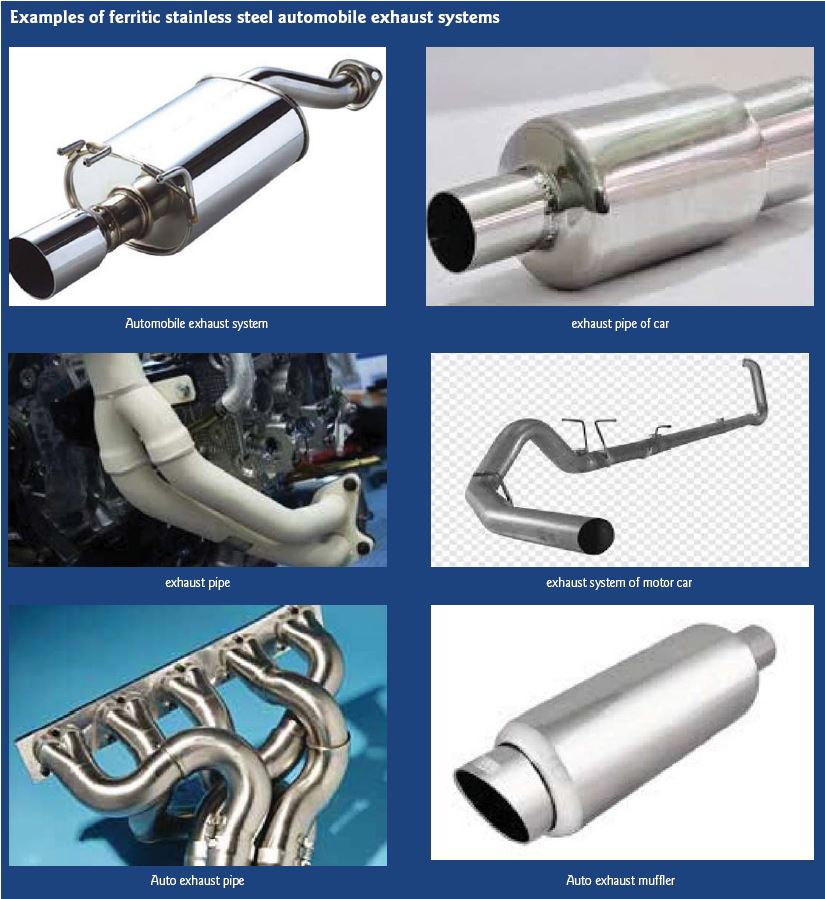An effective exhaust system reduces emissions and increases fuel economy by removing exhaust gases from the controlled combustion inside an engine.
By Srikumar Chakraborty, ex Sr. Executive, ASP/SAIL, Member of Freelance Consulting Team
Vehicle exhaust systems perform the essential function of removing harmful exhaust fumes such as CO2, NO, HC, P, SO2 and Pb from vehicle engines. The materials used in the exhaust system must be resistant to high-temperature oxidation, thermomechanical vibration, external salt corrosion, and internal acid/base corrosion.
Material selection
The selection of material for exhaust systems has a vital role in manufacturing the various exhaust components.
The materials chosen will affect increased warranty requirements and regulatory compliances for meeting the physical, chemical and mechanical properties and the cost for conventional and special applications. For many decades carbon steel was the material of choice for exhaust systems. The iron oxide coating on the exhaust system protected it from atmospheric corrosion to varying degrees. Still, the components suffered deterioration due to poor corrosion resistance when exposed to road salt and exhaust condensate, resulting in a short service life. Applications for carbon steels are now limited to selected non-road applications operated in relatively non-corrosive environments. The exhaust system comprises a manifold, downpipe silencer, muffler box and tailpipe. Each component’s function largely depends on the correct selection of material and their mass, cost, high-temperature properties (>800ºC for exhaust manifold, >400ºC for downpipe silencer/ muffler box and tailpipe) and high corrosion resistance.
Product development
Since the mid-1990s, stainless steels have replaced carbon and low alloy steel in response to market demand for extended warranties, meeting emission standards, and life-cycle cost. Technologies to meet increasingly stringent standards makes the task of complying with strength and durability requirements, especially challenging. Emission standards also require exhaust systems are designed to facilitate leak-free assembly, installation and operation for the full useful life. Ferritic stainless steels are increasingly specified in automotive parts such as exhaust systems and emission control systems. Upgrades have gradually achieved better performance. These have resulted in faster airflow, more power in the engine to generate greater horsepower and torque, better fuel economy, reduced sound, maintaining speed variation/control of the vehicle, and last but certainly not least, fuel economy.
The components in the vehicle exhaust system, e.g. inner cones, baffle plates, retainer rings, perforated pipes, and external components like hanger rod, outer shell, heat shield, end caps outer cones, flex tube, manifold etc. should all be able to withstand high thermal impact and vibrations caused by road load, thermal load and engine load. Ferritic stainless steels are the best choice considering all aspects of the exhaust or flue gases emitted due to fuel combustion such as petrol, diesel or fuel oil. The desired end goal is high strength at high temperatures, plus greater resistance to oxidation and corrosion while meeting the relevant social and economic targets.

Alloy 409
Compared with austenitic stainless steels, ferritics have inherent advantages for use at high temperatures with a low coefficient of thermal expansion, good heat transfer rate, and better oxidation resistance during the heat cycle. However, ferritics are inferior in terms of internal strength, weldability and formability at high temperatures.
Type 409, with a nominal 11% Cr balancing with Ti, offers economic corrosion resistance and good formability. This alloy was developed in the 1960s, as published in US 3,250,611, registered May 10, 1966. The titanium addition stabilises the steel to prevent hardening during welding and prevents the formation of chromium carbides. Welds and weld heat-affected zones perform nearly as well as the base metal in corrosion resistance. Various materials, including nickel-based superalloys, nickel-chromium alloys, etc., are also considered suitable but are too expensive. Table 1 shows the chemical composition and mechanical properties of Alloy 409.

Chemical composition
Today’s exhaust systems make high demands on the materials used. These include high-temperature strength,
high deformation, better surface quality, continuous and periodic thermal oxidation, good formability and weldability, and thinner wall thicknesses. Certain elements help to achieve these goals:
C increases hardness and hardenability while reducing ductility,
Si increases ductility, strength and corrosion resistance,
Mn increases ductility and weldability,
S & P reduce the ductility increasing brittleness,
Mo increases hardenability, hardness, strength, and corrosion resistance,
Cr, Ni, Ti enhance corrosion resistance. Ti-stabilised ferritic steel cannot easily be brazed with fillers such as deoxidation lamps and nickel base alloys. A stabilised ferritic stainless steel composition No. 4.461.811, which can be wetted, by conventional brazing materials was developed in July 1984. In this alloy, 10.5-13.5% of Cr, up to 0.12% titanium and up to 0.12% aluminum plus (+) titanium was added to titanium, tantalum and niobium according to the stabilisation formula. It is desirable to maintain the usual steelmaking impurities in a relatively small amount while steelmaking in an electric arc or induction furnace, and it is preferable to refine at AOD.
Conclusion
The vehicle exhaust system is a critical component to handle waste and remove burnt gases from the engine. Effective exhaust systems produced from stainless steel reduce emission levels, increase fuel economy, and possess properties such as high-temperature oxidation resistance, thermomechanical vibration resistance, external salt corrosion resistance and internal acid/base corrosion resistance.
References
Metals Hand Book, Manufacturing Technology of Exhaust System
Every week we share a new Featured Story with our Stainless Steel community. Join us and let’s share your Featured Story on Stainless Steel World online and in print.
Featured Story by Srikumar Chakraborty, ex Sr. Executive, ASP/SAIL, Member of Freelance Consulting Team


